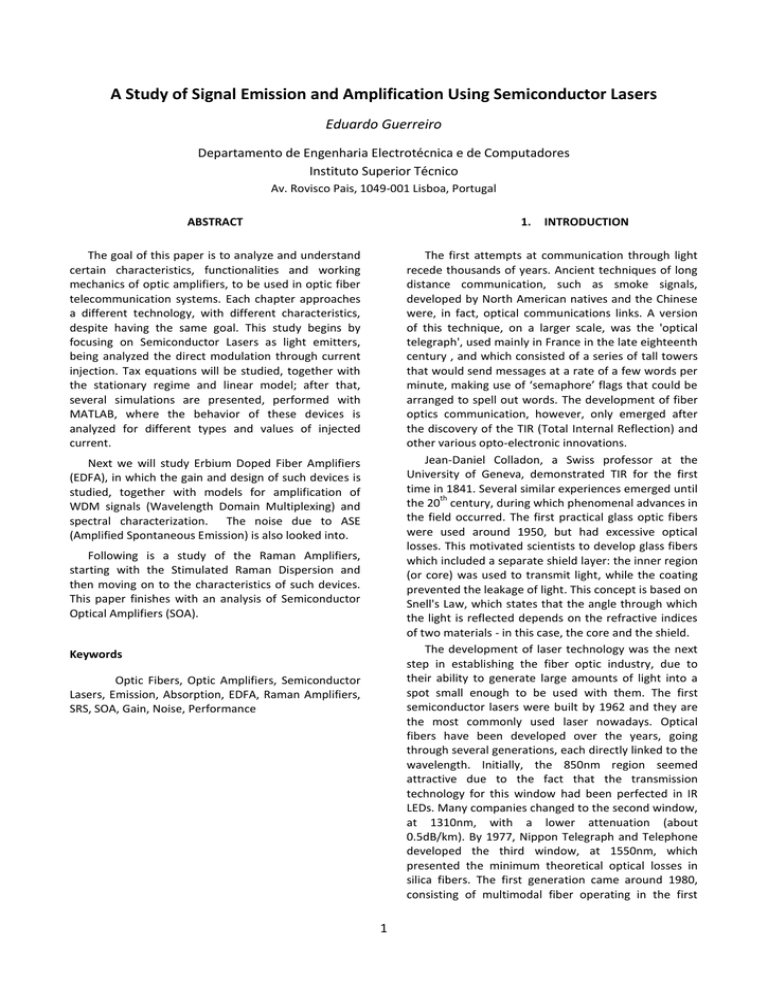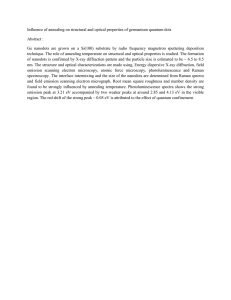A Study of Signal Emission and Amplification Using Semiconductor
advertisement

A Study of Signal Emission and Amplification Using Semiconductor Lasers
Eduardo Guerreiro
Departamento de Engenharia Electrotécnica e de Computadores
Instituto Superior Técnico
Av. Rovisco Pais, 1049-001 Lisboa, Portugal
ABSTRACT
1.
The goal of this paper is to analyze and understand
certain characteristics, functionalities and working
mechanics of optic amplifiers, to be used in optic fiber
telecommunication systems. Each chapter approaches
a different technology, with different characteristics,
despite having the same goal. This study begins by
focusing on Semiconductor Lasers as light emitters,
being analyzed the direct modulation through current
injection. Tax equations will be studied, together with
the stationary regime and linear model; after that,
several simulations are presented, performed with
MATLAB, where the behavior of these devices is
analyzed for different types and values of injected
current.
INTRODUCTION
The first attempts at communication through light
recede thousands of years. Ancient techniques of long
distance communication, such as smoke signals,
developed by North American natives and the Chinese
were, in fact, optical communications links. A version
of this technique, on a larger scale, was the 'optical
telegraph', used mainly in France in the late eighteenth
century , and which consisted of a series of tall towers
that would send messages at a rate of a few words per
minute, making use of ‘semaphore’ flags that could be
arranged to spell out words. The development of fiber
optics communication, however, only emerged after
the discovery of the TIR (Total Internal Reflection) and
other various opto-electronic innovations.
Jean-Daniel Colladon, a Swiss professor at the
University of Geneva, demonstrated TIR for the first
time in 1841. Several similar experiences emerged until
th
the 20 century, during which phenomenal advances in
the field occurred. The first practical glass optic fibers
were used around 1950, but had excessive optical
losses. This motivated scientists to develop glass fibers
which included a separate shield layer: the inner region
(or core) was used to transmit light, while the coating
prevented the leakage of light. This concept is based on
Snell's Law, which states that the angle through which
the light is reflected depends on the refractive indices
of two materials - in this case, the core and the shield.
The development of laser technology was the next
step in establishing the fiber optic industry, due to
their ability to generate large amounts of light into a
spot small enough to be used with them. The first
semiconductor lasers were built by 1962 and they are
the most commonly used laser nowadays. Optical
fibers have been developed over the years, going
through several generations, each directly linked to the
wavelength. Initially, the 850nm region seemed
attractive due to the fact that the transmission
technology for this window had been perfected in IR
LEDs. Many companies changed to the second window,
at 1310nm, with a lower attenuation (about
0.5dB/km). By 1977, Nippon Telegraph and Telephone
developed the third window, at 1550nm, which
presented the minimum theoretical optical losses in
silica fibers. The first generation came around 1980,
consisting of multimodal fiber operating in the first
Next we will study Erbium Doped Fiber Amplifiers
(EDFA), in which the gain and design of such devices is
studied, together with models for amplification of
WDM signals (Wavelength Domain Multiplexing) and
spectral characterization. The noise due to ASE
(Amplified Spontaneous Emission) is also looked into.
Following is a study of the Raman Amplifiers,
starting with the Stimulated Raman Dispersion and
then moving on to the characteristics of such devices.
This paper finishes with an analysis of Semiconductor
Optical Amplifiers (SOA).
Keywords
Optic Fibers, Optic Amplifiers, Semiconductor
Lasers, Emission, Absorption, EDFA, Raman Amplifiers,
SRS, SOA, Gain, Noise, Performance
1
window, with a bit rate of about 45 Mb/s and 10km
spacing between repeaters. The second generation
began in 1987, operating in the second window, with
attenuation below 1dB/km and minimal dispersion,
leading to around 1.7 Gb/s and 50km between
repeaters. The third window, operating in the 1550nm
region, allows a minimum attenuation of about 0.2
dB/km and rates of approximately 10 Gb/s. The great
evolution of this third generation comes with the
advent of optical amplifiers, which amplify signals
without using optical-electric-optical conversions. With
the advent of the EDFA it was possible to significantly
increase the spacing between repeaters. The fourth
generation has, as main features, the fact that it works
in the optical domain, where WDM being applied
increased capacity and transmission rate.
dependent on the photon number. In this case, the
electron population is a constant, as it doesn’t depend
on the injection current, and is given by
(2.4)
and is only valid when the laser is emitting (when
). On the other hand, if we have
,
(2.5)
On the oscillation threshold, the electron
population reaches the maximum
value mentioned
above and, with this, we have a threshold current given
by
(2.6)
and
2. SEMICONDUCTOR LASER MODULATION THROUGH
PUMP CURRENT
(2.7)
2.2. Numeric Simulations
The definition of a semiconductor is that of a solid
material (crystalline or amorphous) whose electrical
conductivity, usually between that of a conductor and
an insulator, can be modified significantly. This
electrical conductivity variation can be achieved
through various processes, such as illuminating the
material with light, doping it or even simply varying the
temperature. The laser consists of an active layer to
produce gain. This gain has to do with the fact that, by
stimulated emission, the incident radiation is
considerably less than the radiation produced by the
semiconductor device. Through injected current, the
pumping will increase the population of electrons in
the conduction band, and the population of holes in
the valence band.
For simulation purposes, we will consider a
rectangular injection current (with several values) and
a semiconductor laser with the following
characteristics:
2
Table 1 - Stimulated emission elementary net rate, Total
electron population, spontaneous emission factor, average
photon lifetime, uninduced recombination time and Gain
compression coefficient
Rectangular injection current
2.1. Stationary Regime
In the stationary regime, the rate equation is
(
(2.8)
)
(2.1)
From here, we can derive
st
2.2.1. 1 case: I0=2Ith , Im=Ith
(2.2)
With the above values, we get
(2.3)
where
and
are constants,
is the linear
regime rate of spontaneous recombination and
correspond, respectively, to the number of
stationary regime electrons and photons. Usually, the
function isn’t linear. Still, only the
simplest case will be analyzed, when
, not
(
2
(
))
(2.9)
conduction band, we can see in the last two figures
that, when injection current is applied, the number of
electrons increases much faster than the photon
number. This increase will lead to an increase in the
stimulated emission rate, which will eventually lead to
a rapid increase in photon number and subsequent
radiative recombination (characterized by reducing the
number of electrons in the cavity due do the transition
from conduction to valence band). All this will, again,
lead to an increase in electron population, as the
photon number falls, which characterizes the
oscillatory nature of electron/photon number in cavity.
When the T current pulse ends, the oscillation tends to
stabilize.
For T=2ns:
nd
2.2.2. 2 case: I0=0.7Ith , Im=2Ith
Figure 1 - Injection current [mA] as a function of Time [ns]
With the above values, we get
(
(
))
(2.10)
For T=0.7ns:
8
Figure 2 – Electron population on cavity [10 ] as a function
of Time [ns]
Figure 4 - Injection current [mA] as a function of Time [ns]
5
Figure 3 - Photo population [10 ] as a function of Time [ns]
From the above simulations we can conclude that
the laser is working properly, which was expected as
the injection current is higher than the oscillation
threshold, leading to population inversion. Because of
that, there is only photon emission starting at the
threshold current, required for stimulated emission.
Due to the moving of electrons from valence band to
6
Figure 5 – Photon population [10 ] as a function of Time [ns]
3
third window rather than in the second, and the latter
has not produced satisfactory results.
An EDFA is a fiber doped with erbium ions, which
exhibit a certain radioactive decay, and the excited
state lifetime is sufficient for pumping.
3.1. Gain
The fact that each wavelength has a characteristic
gain makes the spectrum the most import
characteristic of an EDFA: it will determine the level of
amplification for each channel. The amplification’s gain
is given by
8
Figure 6 – Electron population on cavity [10 ] as a function
of Time [ns]
(3.1)
In this case, there is no population inversion. This is
due to the fact that the injection current is a fraction of
the threshold current needed to emit photons.
Electron population will tend to
when the current
impulse ends. The laser will behave similar to the
previous case, in the way that current is injected to
obtain a population inversion, which will increase
photon population increase, followed by lowering of
electron number. This will eventually increase, due to
injected current and absorption on existent photons,
which will again lower the number of photons.
Spontaneous and stimulated emission will again
increase the population of photons, repeating the
whole loop again. These populations will stabilize when
the current pulse ends:
and
.
where the emission coefficient
is
(3.2)
and the absorption coefficient
is
(3.3)
is the coefficient relating efficient sections of
emission and absorption
(3.4)
is the optical confinement factor,
is the efficient
emission section,
is the efficient absorption section
and is the effective ray of erbium ions concentration.
3. AMPLIFICATION THROUGH THE USE OF ERBIUM
DOPED FIBER AMPLIFIERS (EDFA)
3.2. Models for WDM signal amplification
The first generation of optical communication
systems was developed around 1975, with the third
generation coming in the late 80s. These third
generation systems would operate in the third window,
in 1.55 µm, with bit rates up to 10 Gb/s and using
electronic repeaters with typical 60-70km spacing.
With the advent of the EDFAs this was solved, as the
pumping is done by semiconductor lasers; they began
being commercialized in 1990 and allowed for a
distance between repeaters of 60-100km, directly
amplifying signals without any electro-optic
conversions, in an opposite way compared to what
happens when using 3R regenerators.
Despite all of this, there still are some problems
with the use of these fiber amplifiers, in particular due
to chromatic dispersion ad various techniques are
being used to overcome them. For example, using DSSMF and dispersion management through the use of
DCFs. Nevertheless, it’s still better to amplify on the
After writing the population invertion coefficient
as
∑
(
∑
)
(3.5)
we can translate the amplification of a WDM signal
through
(3.6)
where
∑
4
(
∑
)
(3.7)
3.3. Simplified model for optimal length EDFA
The EDFA optimal length is the length for which the
maximum gain is achieved (for a given pumping
power), such that
(
(3.8)
)
it’s value being obtained by
(
[
)
]
(3.9)
In case the EDFA’s length is known and not optimal,
we solve eqs. 3.10 for and .
[
{
[
]
(
)
[ (
]
*
)
]
(3.10)
+
Figure 8 - EDFA gain, as a function of Wavelength, in a L
length EDFA
3.4. Spectral characterization
As opposed to what was desirable, and as
represented on Figure 7, the gain achieved through
EDFA use is neither constant nor linear, which makes
its analysis and projection harder. From it, we can note
that, for lengths up to 4 meters, its gain has a bigger
variation in the region between 1520 and 1580nm;
above 6 meters, the EDFA’s gain suffers a bigger
variation in the 1480-1554nm region.
Figure 9 - Output power for four similar wavelenghts, as a
fuction of Lenght [m]
3.5. Amplified Spontaneous Emission noise power and
factor
The ASE, a negative aspect of the EDFA, has an
average noise power given by
Figure 7 - EDFA spectral characterization
(3.11)
The EDFA is very sensitive to the wavelength it
transmits in and its length, which can be seen in both
Figures 8 and 9 respectively, and that makes it
necessary to optimize the EDFA by choosing a specific
optimal length depending on the type of signal to
amplify.
with bandwidth
and spontaneous emission factor
(3.12)
for total population inversion we have
and
(3.13)
the minimum value of ASE related noise.
The noise factor, a ratio between
and
is show on equation 3.14, which has a
minimum value of = 2 dB.
5
4.2. Raman gain and bandwidth
(3.14)
where
is the gain and
noise factor in the input.
In terms of
written as
and equivalent
pumping power, Raman gain can be
(
4. SRS AND RAMAN AMPLIFIER CHARACTERISTICS
)
(4.3)
where the
gain coefficient is related to optical gain
as
and
the transversal section
area of the pumping beam. The
ratio is a good
4.1. Spontaneous Raman Scattering
This phenomenon occurs in optical fibers when a
pumping beam is scattered by the silica molecules.
Some pumping photons emit energy to create photons
of lower energy and frequency, while the energy that
remains is absorbed by these molecules, which end up
in an excited state. SRS is an isotropic process that
occurs in all directions and this scattering process
becomes stimulated if the pumping power exceeds a
threshold value. In the case of forward SRS, both eqs.
4.1 and 4.2 define the feedback process:
efficiency measure for Raman Gain, and it considerably
changes for several fiber types.
These amplifiers are attractive for fiber optic
communications applications, mainly due to their large
bandwidth. However, a relatively large pump power is
mandatory to achieve a high amplification factor: this
power can be reduced for longer fibers, and losses in
the fiber must also be included.
4.3. Amplifier characteristics
(4.1)
Due to large fiber lengths needed for Raman
amplifiers, losses must be taken into account. The
changes in pumping and signal power, during the
length of the amplifier, and in the case of forward
propagating pumping, are given by
(4.2)
where
is the SRS gain and
are the pumping and
Stokes wave currents, respectively; in the case of
backwards SRS, we add a minus sign on the left of
equation 4.2.
(
*(
(
)
)
(4.4)
(4.5)
where (
) represent fiber losses for signal and
pumping frequencies, (
) respectively.
As Raman amplifiers are, unfortunately, a bit
sensitive to polarization, their gain is the greatest when
the signal and the pumping are polarized in the same
direction, so they pumped with two orthogonally
polarized lasers. An advantage is that, if the pumping
wavelength is adequately chosen, we can have these
amplifiers working in any wavelength; all channels
should also have the same gain, so the spectrum
should be uniform. This can be achieved by using
pumps at multiple wavelengths, with the result shown
below on Figure 11.
-13
Figure 10 - Raman gain [10 m/W] in a silica fiber,
for
, as a function of Frequency Offset [THz] [11]
The advantages of this phenomenon (with a gain that
depends on the decay time associated with the excited
vibrational state) are most notable when developing
optical communication systems, as it can amplify an
optic signal by transferring energy to these systems (via
pumping). It has a high bandwidth and its gain is
usually used to compensate fiber losses.
6
√
[
] (5.3)
(
)
√
where the facet reflectivity needs to satisfy
. The fact that the bandwidth of the
√
Fabry-Perot amplifier is small fraction of the spectral
range of the cavity makes these devices inadequate for
most optical systems applications. In this TW operation
type, the signal only passes once through the device, so
facet reflectivity needs to be suppressed. A simple way
to achieve that is to coat these facets, so as to achieve
reflectivities as low as 0.1%.
Figure 11 - Raman gain [dB] as function of Wavelength [nm],
in an 80nm bandwidth [13]
5.2. Characteristics
5. SOA – Semiconductor Optical Amplifier
Assuming a gain peak value, and that it linearly
increses with the carrier population, we have
In the 70s, Zeidler and Personick developed some
initial work in these semiconductor amplifiers and, in
the 80s, there were notable advances in SOA device
projection. In 1989, SOAs began to be projected as
devices on their own, resorting to the use of
symmetrical wave guide structures, much less sensitive
to polarization. Since then, the development of SOAs
has progressed in parallel with advances in
semiconductor materials, device manufacturing, antireflective coating technology and others, coming to the
point where there are, in the market, several reliable
devices at competitive prices.
(
where is the confinement factor,
the differential
gain,
the active volume and
the value of
required for transparency. The saturation power is
given by
(5.5)
with
life time of support and
the cross sectional
area of the waveguide mode; the noise figure is given
by
These amplifiers operate on the concept that one
can change the intensity of a wave in an active
semiconductor, due to the losses of the medium or the
injection of carriers to obtain gain. Attenuation is due
to the absorption of photons, causing an electron
'jump' from the valence band to the conduction band;
amplification occurs when, by injecting current, a
population inversion between the valence band and
conduction happens.
(
*(
*
(5.6)
As mentioned, SOAs are very sensitive to
polarization: the amplifier gain differs from 5 to 8 dB in
TE and TM modes (transverse electric and magnetic,
respectively), as both
and
are different for
orthogonally polarized modes. There are, however,
several configurations to reduce polarization
sensitivity, like having two amplifiers in series, with
different orientations, or diving the signal in one TE
and one TM polarized signals, so as to amplify each in
separate and then recombine them.
5.1. Gain and bandwidth
The
(5.4)
*
gain on these devices is given by
5.3. Pulse amplification
(
√
)
[
√
]
(5.1)
The two equations below govern the amplification
of optical impulses in SOAs, and can be analytically
solved for pulses with shorted duration than the carrier
(
).
where the free pass amplification factor, corresponding
to a traveling wave amplifier, is
[
]
(5.2)
(5.7)
The amplifier bandwidth is determined by the
sharpness of the resonant cavity, and given by
7
| |
both directions and if the pumping current exceeds a
certain value, has been studied. Despite significantly
affecting WDM system performance, it is a beneficial
phenomenon when projecting optic communication
systems. This is due to the fact that it’s possible to
amplify an optical signal by transferring energy to these
systems, using a pump beam with a certain
wavelength. These amplifiers can provide a gain up to
20dB for a pumping power of 1W and, for better
performance, the frequency difference between the
pump and signal beams should be on the order of 13
THz. In WDM systems, their spectrum should be
approximately uniform, accomplished by pumping
current on various wavelengths. A disadvantage is its
sensitivity to polarization, which in turn can be solved
by pumping with two orthogonally polarized lasers.
In section 5, Semiconductor Optical Amplifiers were
studied. These also exhibit great sensitivity to
polarization, just as Raman amplifiers; this can be
reduced using various configurations. It was also found
that it is necessary to suppress reflections on the end
facets of the SOA, using anti-reflection coatings, and
that these devices have a noise factor larger than the
minimum 3dB value, due to its internal losses and
spontaneous emission factor).
(5.8)
The amplification factor is given by
[
]
(5.9)
where
is the unsaturated gain and
is the partial energy of the input pulse
∫
and the phase shift by
[
(5.10)
]
The chirp frequency is related to the phase shift, as
seen below on eq. 5.11.
[
]
(5.11)
These two last variables, the chirp frequency and phase
shift, can significantly affect optical systems.
6. CONCLUSIONS
In section 2, semiconductor lasers were studied: by
pumping through by a current injection, in order that
the emission predominates over the absorption, an
inversion of population is achieved. That way, the
number of holes in valence band and the number of
electrons in conducting band increases. When the laser
is emitting (
), the electron and photon
population has an oscillatory profile; the higher the
injected current, the quickly the population stabilizes.
If the laser isn’t emitting (
), there is no
population inversion and no photon emission. When
the injected current pulse ends, the electron
population tends to .
In the next section we analyzed the EDFAs and the
associated amplification process. The power comes
from a laser and is the greatest at the time of pumping.
In the case of projecting only one channel, it was noted
that the maximum gain is obtained for the third
window; in WDM systems several channels are
amplified, with different gains and saturation points.
The influence ASE noise was examined and, in addition
to showing that these devices are very sensitive to its
length and wavelength transmission (depending on the
type of signal to be amplified it’s necessary to
determine their optimal length), it was also concluded
that this noise is minimal when there is a total
population inversion.
Then the Raman amplifiers were studied. The
phenomenon of Stimulated Raman Amplification
(especially useful because of its extremely large
bandwidth), which may occur in optical fibers, along
7. REFERENCES
1. Paiva, Carlos Manuel dos Reis. Fibras Ópticas. Notas de
Fotónica. 2008.
2. —. Cavidades Ópticas de Fabry-Perot. Notas de Fotónica.
2008.
3. —. Lasers Semicondutores. Notas de Fotónica. 2008.
4. —. Fibras Amplificadoras Dopadas com Érbio. Notas de
Fotónica. 2008.
5. Cartaxo, Adolfo da Visitação Tregeira. Comunicações
Ópticas. Sistemas de Telecomunicações em Fibras Ópticas.
2012.
6. Fiber-optic communication. Wikipedia. [Online]
http://en.wikipedia.org/wiki/Fiber-optic_communication.
7. Chitz, Edson. Amplificadores: a Fibra Dopada com Érbio.
Bate Byte. [Online] 2009.
www.batebyte.pr.gov.br/modules/conteudo/conteudo.php?
conteudo=1601.
8. Lamperski, Jan. Gain Coefficient. Invocom. [Online]
www.invocom.et.put.poznan.pl/~invocom/C/P19/swiatlowody_en/p1-1_4_5.htm.
9. Paschotta, Rüdiger. Erbium-doped Gain Media. RP
Photonics. [Online] www.rpphotonics.com/erbium_doped_gain_media.html.
10. Raman fiber amplifiers. Dianov, Evgenii Mikhailovich.
Moscow, Russia : Fiber Optics Research Center at the General
Physics Institute, Russian Academy of Sciences, 2000,
Advances in Fiber Optics.
8
11. Paschotta, Rüdiger. Raman Gain. RP Photonics. [Online]
www.rp-photonics.com/raman_gain.html.
12. MATLAB Simulink modeling of Raman hybrid amplification
for long-distance hut-skipped undersea optical fiber
transmission systems. Binh, Le Nguyen. 10, 2009, Optical
Engineering, Vol. 48.
13. Fiber-Optic Communication System. Agrawal, G. P. New
York : Wiley, 2002.
14. Dutta N.K., Wang Q. Semiconductor Optical Amplifiers.
2006. ISBN 9812563970.
15. Connely, Michael J. Semiconductor Optical Amplifiers.
s.l. : Kluwer Academic Publishers, 2002.
16. Filho, Carmelo José Albanez Bastos. Amplificadores
Ópticos para Sistemas de Comunicação Multicanais de Alta
Capacidade. Recife : s.n., 2005.
17. Goff, David R. Fiber Optic Video Transmission. 1st.
Woburn, Massachusetts : Focal Press, 2003.
18. Neto, Adriano Domingos. Mistura e Geração
Experimental de Sinais Microonda Empregando
Amplificadores Ópticos Semicondutores. 1998.
19. Saleh, B. E. A. , Teich, M. C. Fiber-Optic Communications
em Fundamentals of Photonics. 2001.
20. Einstein Coefficients. Wikipedia. [Online]
http://en.wikipedia.org/wiki/Einstein_coefficients.
9




